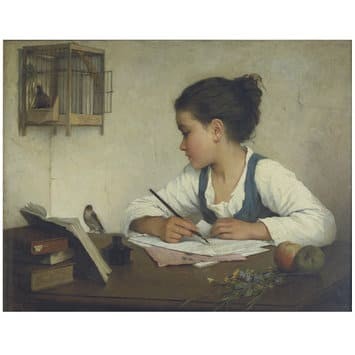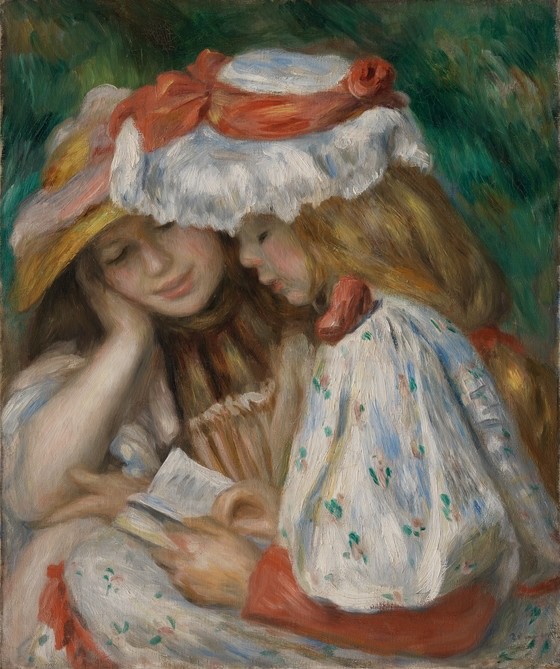This blog first appeared on February 22, 2020. It has been a while since I have written about how writing instruction can boost reading achievement. When I first started writing about that (almost 50 years ago), it was virtually an unknown topic. These days, most teachers tell me that they agree that writing can improve reading, though they don’t seem to have much understanding of the concept and quite often they skip the writing because of pressures to get higher reading scores. So it goes. Given recent experiences with such conversations, I thought it would be a good time to revisit the topic. There was nothing to change or update here but the original had no references, so I cited some of my contributions in this arena. I still believe that a quarter of your language arts instruction should focus on writing – and this entry provides practical advice to help you accomplish that in ways that can build both reading and writing.
RELATED: What Does Brain Science Have To Say About Teaching Reading? Does It Matter?
Teacher question:
Everyone says reading and writing are connected. But our school focuses on only reading. We have a reading program (we don’t have a writing program). We test the students three times a year in reading, but never in writing. Writing isn’t even on our report card, though I guess it is part of Language Arts. What should we be doing with writing?
Shanahan response:
You came to the right place.
I think your school is making a big mistake not devoting sufficient attention to writing.
When I was a teacher my primary grade kids wrote every day. When I became a researcher, I conducted studies on how reading and writing are related. As director of reading for Chicago, I required 30-45 minutes per day of writing in all our classrooms.
There are, of course, a lot of good reasons why someone should learn to write. Many jobs, mine included, require it – and often jobs that require a lot of writing pay better (I’m sure many nurses would disagree with that last point). Of course, writing is also an important form of self-expression. Just as there are people who play musical instruments, dance, sing, paint, knit, cook, and so on, many use writing as a form of self-expression and to preserve memory. All those are terrific reasons for teaching writing.
I’m going to guess that the reason your school is ignoring writing is because someone thought that might help raise reading scores. That’s a mistake because writing can be a path to higher reading achievement, so your kids (and your school) are missing out. Instead of elevating the reading scores, your school is probably squashing them.
So, there are lots of reasons for teaching writing, and this entry focuses on one of them: how writing can help kids to become measurably better readers.
Research has identified three important ways reading and writing are connected – and all three deserve a place in your curriculum.
First, reading and writing draw upon the same body of knowledge and skills. If you want to be a reader you must perceive the separable phonemes within words, recognize the most common spelling patterns, link meanings to the words in the text (vocabulary), understand the grammar well enough to permit comprehension, trail cohesive links accurately, and recognize and use discourse structure (texts are organized and recognizing this in a text improves comprehension). Of course, background knowledge plays a role in reading comprehension, too, so the more readers know about their world the better they may do in reading. Yep, learning to read requires all of that.
But think about it. That knowledge is integral to writing too. If kids can’t hear the phonemes, match sounds and letters, and remember spelling patterns, they won’t be able to get words on the page. The same can be said about all those other linguistic and content features of text needed for reading. That means when you are teaching the foundations of reading, you are also teaching the foundations of writing.
It is the same knowledge base, and yet, they play out differently because readers and writers start in different places. A reader looks at the author’s words and starts decoding—matching the phonology in their head to the author’s orthography. The writer thinks about the words he/she wants to write, thinks about the phonemes, and tries to remember what letters or patterns will represent those. The same thing happens with the other elements, too – one starts with ideas and turns them into written language, and the other marches in the opposite direction.
What is my advice about taking advantage of this overlap? Teach the reading skills that you teach now, but then think hard about them. How would kids use that skill in reading and writing? For example, when you teach letter sounds, you should be teaching kids to use those sounds to sound out words. It is a pathetic phonics lesson that includes no decoding practice. But also have your students try to write the words. Many programs include dictation, and that’s great.
I’m partial to invented spelling because it provides such extensive and supportive practice with the sounds. Look at this simple K-1 message:
Hermet Krabs liv in shels sum tims tha lev on the bech.
[Hermit crabs live in shells. Sometimes they live on the beach.]
This piece of writing didn’t take long to produce, but to accomplish it the student had to analyze 38 phonemes. He got most of them reasonably right, too. The most ambitious phonemic awareness lessons usually would NOT have any individual child practicing 38 phonemes, so encouraging this kind of writing is smart teaching.
You can do the same with older kids when you teach informational text structure. For reading, that would usually entail teaching how problem-solution texts are organized, and then having the students read texts with that structure to gin up comprehension. That can be even more effective if the kids try to compose their own problem-solution texts – and what a great opportunity to review science or social studies content at the same time.
Second, reading and writing are communication processes. Studies show that writers think about their audiences and what they need to tell their readers to communicate effectively. That might not be surprising, but there are also studies showing the value of having readers think about authors and authors’ perspectives (this is emphasized in educational standards and is essential for reading history and for certain approaches to literary text, too).
Writing approaches that involve kids in reading and responding to each other’s texts are beneficial in improving the quality of kids’ writing. There are any number of ways that teachers can facilitate this kind of sharing and heighten awareness that texts are written by somebody. Doing this can sensitize young authors to the kinds of things that may confuse or entice their readers. Writing conferences, writer’s workshop, and revision circles are just a few ways this can be done.
On the reading side, it can help to read texts in which authors have a strong voice and/or style. It is terrific when kindergarteners find that they can recognize Dr. Seuss books or when third graders can distinguish a Beverly Cleary from a Barbara Cooney with their eyes closed. I like to have these students write imaginary biographies of the authors, based only on the content and tone of the texts we are reading. Of course, as kids get older, these kinds of things are addressed by having students read primary source text sets in their social studies classes and evaluating the trustworthiness of this material based on who the authors are and when they recorded their ideas.
Being author can give students insights into what is happening off-stage (what is the author doing back there?), which can boost critical reading ability. Likewise, being a thoughtful writer gives writers insights into what their readers might need.
The third way that reading and writing can connect is through combined use. Reading and writing can be used together to accomplish goals. Most research on combined uses emphasize two specific academic goals, so I’ll limit my comments to those; specifically, studying or learning from text and composing synthesis papers, like school reports.
In the first, writing is added to reading to increase understanding or improve memory. Research finds that writing about what one is trying to learn from text is beneficial. Often when students read for a test, they read and reread and hope for the best. Studies show that reading and writing summaries, analyses/critiques, or syntheses of the information has a powerful and positive impact on learning. We should be teaching students how to use writing in concert with reading to improve comprehension, increase knowledge, and conquer academia.
The second body of research explores synthesis writing. Teaching students how to collect information appropriately from text sources enables easier and more effective syntheses. Instead of just having kids write a report with three sources or something like that, guide them to plan a paper with a particular purpose or structure and then help them to read the texts in ways that will facilitate this writing. For instance, if students are to write some kind of comparison of sources, provide a summarization guide that facilitates the collection of comparable information from the two texts (such as charting which points on which the texts agree and disagree). Reading the texts in that way should enhance the writing.
Too many principals think that ignoring and even discouraging writing frees up time better devoted to higher reading scores. Too many teachers are anxious about writing because of the limited preparation they receive in this area. But having kids writing every day – in any and all of the ways described here is a good idea.
Not doing so leaves reading achievement points on the table.
As Vivian says in Pretty Woman: “BIG MISTAKE!”
References
Fitzgerald, J., & Shanahan, T. (2000). Reading and writing relations and their development. Educational Psychologist, 35, 39–51.
Shanahan, T. (1984). Nature of the reading-writing relation: An exploratory multivariate analysis. Journal of Educational Psychology, 76, 466–477.
Shanahan, T. (1997). Reading-writing relationships, thematic units, inquiry learning… In pursuit of effective integrated instruction. The Reading Teacher, 51, 12–19.
Shanahan, T. (1998). Readers’ awareness of author. In R. C. Calfee & N. Spivey (Eds.), The reading-writing connection. Ninety-seventh Yearbook of the National Society for the Study of Education (part II, pp. 88–111). Chicago: NSSE.
Shanahan, T. (2004). Overcoming the dominance of communication: Writing to think and to learn. In T. L. Jetton & J. A. Dole (Eds.), Adolescent literacy research and practice (pp. 59–74). New York: Guilford.
Shanahan, T. (2006). Relations among oral language, reading, and writing development. In C. A. MacArthur, S. Graham, & J. Fitzgerald (Eds.), Handbook of writing research (pp. 171—186). New York: Guilford Press.
Shanahan, T. (2016). Relationships between reading and writing development. In C A. MacArthur, Steve Graham, & Jill Fitzgerald (Eds.), Handbook of writing research (2nd ed., pp. 194-210). New York: The Guilford Press.
Shanahan, T. (2019). Reading-writing connections. In S. Graham, C.A. MacArthur, & M. Hebert (Eds.), Best practices in writing instruction (3rd ed., pp. 309-332). New York: Guilford Press.
Shanahan, T. (Ed.). (1990). Reading and writing together: New perspectives for the classroom. Norwood, MA: Christopher Gordon.
Shanahan, T. & Lomax, R. (1986). An analysis and comparison of theoretical models of the reading-writing relationship. Journal of Educational Psychology, 78, 116–123.
Shanahan, T., & Lomax, R. (1988). A developmental comparison of three theoretical models of the reading-writing relationship. Research in the Teaching of English, 22, 196–212.
Shanahan, T., & Tierney, R. J. (1990). Reading-writing connections: The relations among three research traditions. In J. Zutell & S. McCormick (Eds.), Literacy theory and research: Analyses from multiple paradigms. (Thirty-ninth Yearbook of the National Reading Conference, pp. 13–34). Chicago, IL: National Reading Conference.
Tierney, R., & Shanahan, T. (1991). Reading-writing relationships: Processes, transactions, outcomes. In P. D. Pearson, R. Barr, M. Kamil, & P. Mosenthal (Eds.), Handbook of Reading Research (vol. 2, pp. 246–280). New York: Longman.
Here is a link to the original posting of this blog in case you would like to see the 26 comments that were made in response to it.
https://www.shanahanonliteracy.com/blog/how-can-we-take-advantage-of-reading-writing-relationships
LISTEN TO MORE: Shanahan On Literacy Podcast







Comments
See what others have to say about this topic.